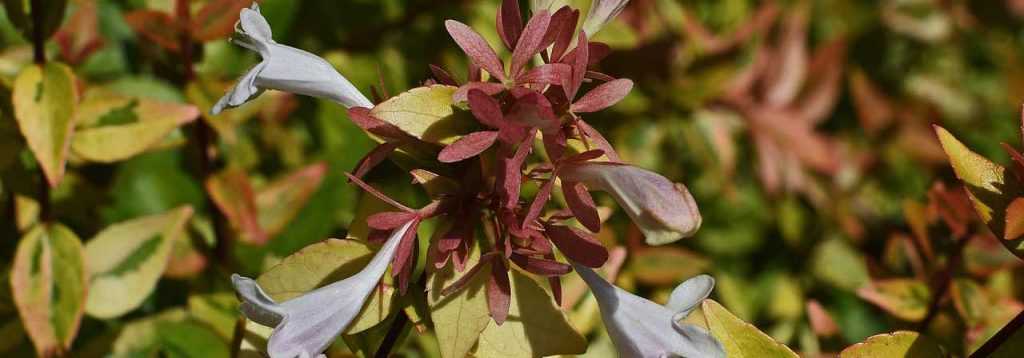
Abelia: Planting, Growing Advice, Pruning and Care
Contents
The Abelia in a nutshell
- Its decorative foliage is highly changeable
- In summer, it produces an abundance of white or pink flowers, often fragrant
- Its modest size makes it ideal for small gardens and container growing
- It makes an excellent hedging shrub
- Hardy and vigorous, it adapts to all soil types
Our expert's word
The Abelia is a beautiful, floriferous shrub with decorative foliage, deserving a place in all gardens with relatively mild winters. Still somewhat rare, it is nonetheless highly floriferous, producing an abundance of small white or pink flowers from June to October, which—depending on the variety—release an extraordinary fragrance of jasmine and lilac.
Its graceful, arching habit, long and generous flowering period, followed in autumn by striking copper-toned bracts that persist against foliage turning purple or reddish, make it an essential feature in summer and late-season garden displays.
From Abelia grandiflora ‘Kaleidoscope’ to Abelia triflora, including Abelia grandiflora ‘Sherwood’ or the hardier Abelia x grandiflora ‘Edward Goucher’, all are easy to grow in the garden, in sun or partial shade, in any well-drained soil and sheltered from strong winds.
Hardy to around -10°C, undemanding, drought- and pollution-resistant, and disease-free, Abelia is invaluable in both urban and natural gardens.
Its compact size and dense growth habit allow for versatile uses: in informal or clipped hedges, mixed borders, pathway edging, low hedges, ground cover, group plantings, and even in pots near entrances to fully enjoy the fragrant varieties.
Grow this vigorous shrub with its sumptuous foliage and dazzling blooms! Our exceptional Abelia collection will surprise you, bringing elegance and fragrance to your garden.
Botany
Botanical data
- Latin name Abelia
- Family Caprifoliacées
- Common name Abelia
- Flowering De juin à octobre
- Height de 1,50 à 3 m
- Exposure Soleil, mi-ombre
- Soil type Tous, bien drainé
- Hardiness -10°C
Abelia is a shrub from the Caprifoliaceae family, native to China. The genus includes about thirty deciduous or semi-evergreen species, sometimes even evergreen in mild climates.
Among the most common varieties, we find notably the Abelia x grandiflora, undoubtedly the most well-known and vigorous of all Abelias. It has given rise to remarkable cultivars or hybrids such as ‘Kaleidoscope’, ‘Francis Mason’ with variegated foliage, or ‘Sherwood’. There’s also the Abelia x grandiflora ‘Edward Goucher’, a more cold-resistant hybrid variety, making it the hardiest of Abelias (-15°C).
The Abelia (x) grandiflora Confetti is a recent horticultural hybrid derived from Abelia (x) Grandiflora, resulting from a cross between Abelia chinensis and Abelia uniflora, appreciated for its variegated foliage and modest size, much like the ‘Prostrata’ cultivar, also cream-variegated.
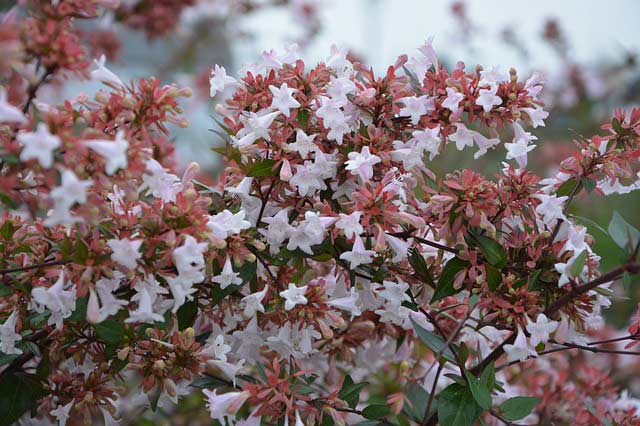

The highly floriferous and vigorous Abelia x Grandiflora has given rise to many interesting cultivars
Abelia chinensis, also called Chinese Abelia, emits a powerful fragrance. Abelia floribunda is a species to train in sunny spots, while Abelia triflora is the tallest (5 m) and most fragrant, with flowers grouped in threes at the leaf axils.
Among the rarer species, there’s the remarkably fragrant Abelia zanderi, a little-known Chinese species, hardy, with a compact yet spreading habit, and Abelia schumannii, which produces rose-violet flowers marked with orange.
With moderately fast growth, depending on growing conditions, Abelia can reach 2.50 m in height with a spread of 2 to 3 m in 5 years. In our gardens, most are modest in size and often don’t exceed 1.80 m in height. Variegated varieties grow more slowly and are more fragile.
There are even dwarf varieties now available, such as Abelia (x) Pastel Charm® from Minier nurseries’ research, which won’t exceed 1 m in any direction.
The habit varies depending on species and varieties: arching, gracefully cascading in Abelia ‘Edward Goucher’, semi-cascading in A. ‘Francis Mason’, rounded and supple in Abelia x grandiflora, naturally compact in Abelia (x) grandiflora Sunny Charm®, bushy and spreading in Abelia chinensis.
Abelia offers a long, fragrant flowering that lasts all summer, from June to September-October, depending on the climate, when few shrubs are still in bloom. In spring, its flowering shoots are very decorative. But it’s in midsummer that its flowering is most generous: a profusion of small trumpet-shaped flowers in white-pink, lilac-pink, pale lavender, cherry pink, or golden yellow appear, grouped in terminal panicles at the ends of young shoots.
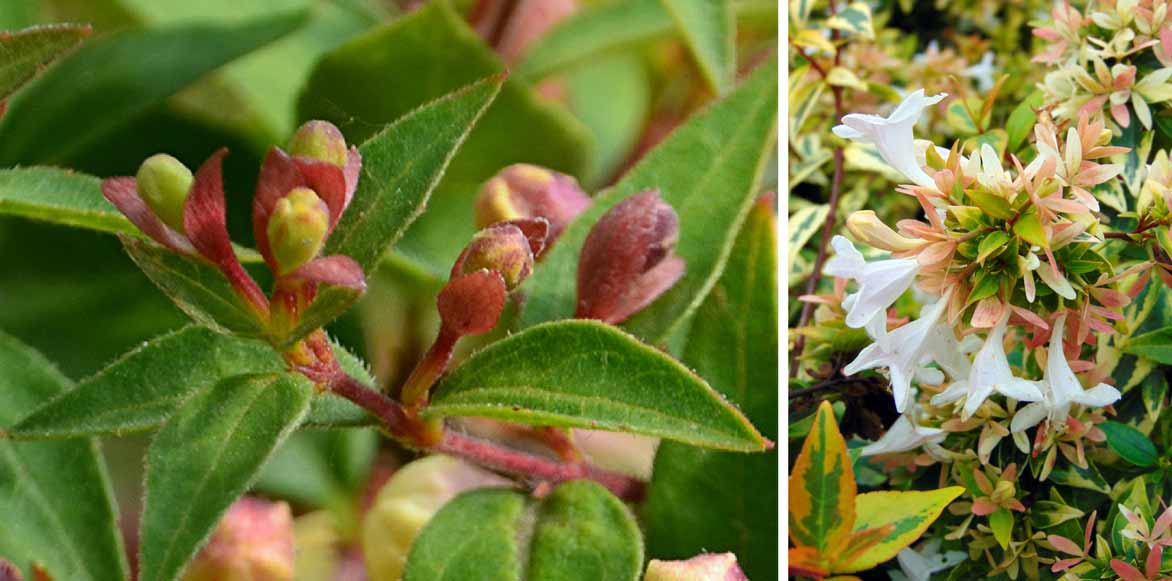

After flowering, the flowers give way to calyxes composed of russet bracts that persist for a long time on the shrub
Sometimes the inside of the corolla, pure white, pink, or pale yellow, offers a lovely contrast in hue with a slightly deeper reverse, powdery pink or white-mauve. These countless small tubular corollas (A. floribunda) or funnel-shaped ones, 2 to 5 cm long, composed of 2 to 5 funnel-shaped sepals, continue until autumn.
They emit a fresh fragrance, more or less powerful, of lilac, jasmine mixed with hyacinth, which perfumes summer evenings. They are frequently visited by butterflies and other pollinators. The flowering is followed by the appearance of fruits, the achenes, which contain only one seed.
Each is delicately enclosed in a pink, bright pink, green, or brown-red calyx, depending on the variety, which persists well after the flowers fall. Once faded, the flowers give way to these calyxes composed of abundant coppery bracts that remain on the shrub for a long time, creating a sumptuous echo with the purple-bronze autumn foliage.
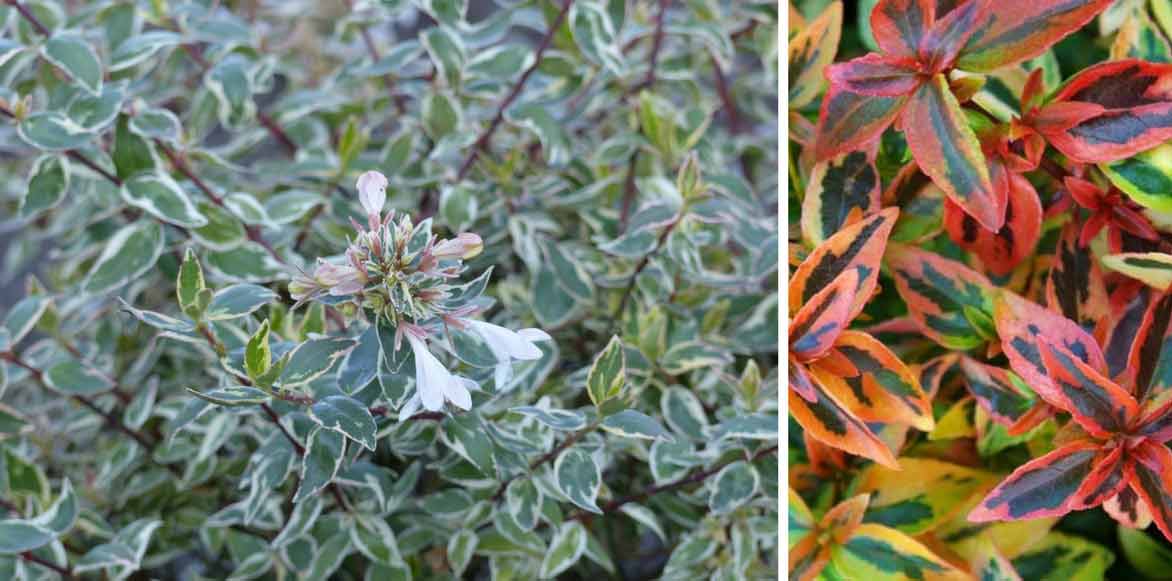

In autumn, the leaves often take on sumptuous purple, reddish, bronze-reflected hues that persist for a long time on the branches, unless frost takes them away
This beautiful shrub has foliage that is more or less evergreen depending on the mildness of the climate. From spring, it reveals its young shoots and often reddish branches. This more or less arching and particularly decorative framework bears small oval to rounded leaves, more or less toothed, 3 to 8 cm long, opposite or sometimes grouped in clusters.
Dark green and glossy all summer for most, they are remarkably variegated in some, offering golden foliage with changing reflections depending on the season: Abelia ‘Confetti’ has light green leaves edged with white-cream that reveal beautiful pink hues at the first frosts, while Abelia grandiflora ‘Francis Mason’ has dark green foliage variegated with golden yellow.
Low-maintenance and easy to grow, Abelia thrives in sunny or partially shaded positions, sheltered from cold, drying winter winds. Not fussy about soil type, it prefers light, well-drained soils and even tolerates poor, chalky soil. It withstands summer drought well but dislikes heavy, waterlogged, and clay soils.
Although hardy, Abelia prefers mild winters and is ideally cultivated up to the Île-de-France region, south of the Loire, in Brittany and the Southwest, where winter temperatures don’t drop below -10°C to -12°C, even for the hardier grandiflora varieties. It fears icy winds and severe frosts. However, it tolerates drought quite well and resists wind and sea spray perfectly, making it suitable for coastal gardens. It’s a vigorous shrub very resistant to most diseases and pests: it has no known enemies.
Abelia is a versatile shrub that fits perfectly into all gardens, working wonders in small spaces. It tolerates pollution, making it an excellent urban shrub. Its moderate size and dense silhouette allow for many uses: in beds combined with asters, Japanese anemones, tricyrtis, as a standalone, in a grove, in a free hedge accompanied by Leycesteria formosa (Desmodium) for a lovely contrast, in a flowering hedge with buddleias, kolwitzia, mock oranges, ceanothus, Caryopteris, Berberis, shrub roses, or even a Choisya, in a low hedge for dwarf varieties, and even grown in large pots near the entrance in mild winter regions to fully enjoy its fragrance.
Some varieties like ‘Confetti’, measuring less than 1m in all directions, make excellent ground covers.
It can be paired with shrubs with variegated foliage like Dogwoods or Photinia. Its slightly unruly form will offer a beautiful contrast with plants with a stricter habit like bamboos, pampas grasses, or Japanese maples.
Read also
How to take cuttings from abelia?Species and main varieties
Abelias offer multiple seasonal interests. The main selection criteria are flower colour, summer and autumn foliage, mature size, and sometimes the growth habit which can range from compact to bushy.
The Abelia x grandiflora, a hybrid obtained by crossing Abelia chinensis and A. uniflora, is undoubtedly the most well-known of the genus and also the most vigorous of all Abelias. Grandiflora varieties are more vigorous but remain hardy only down to -10°C. Also very popular is the Abelia x grandiflora ‘Edward Goucher’; this small hybrid is the hardiest of Abelias, tolerating temperatures as low as -15°C.
The Abelia chinensis or Chinese Abelia, is one of the most floriferous and fragrant. Among the rarer species, there’s also Abelia zanderi, a little-known Chinese species with a compact, bushy habit and its cultivar ‘Little Richard’, and Abelia schumannii, a deciduous shrub with orange-pink flowers.
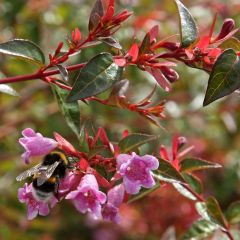
Abelia Edward Goucher
- Flowering time September to November
- Height at maturity 1,80 m
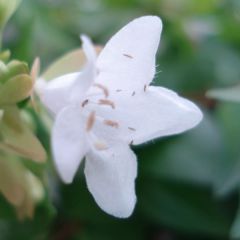
Abelia grandiflora Francis Mason
- Flowering time August to October
- Height at maturity 1,50 m
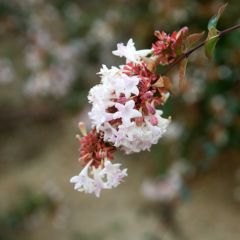
Abelia grandiflora - Abelia with large flowers
- Flowering time August to November
- Height at maturity 2,50 m

Abelia chinensis
- Flowering time September to November
- Height at maturity 2 m
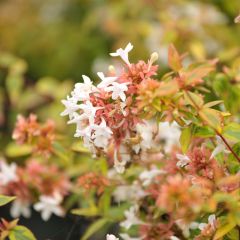
Abelia x grandiflora Kaleidoscope
- Flowering time July to November
- Height at maturity 80 cm
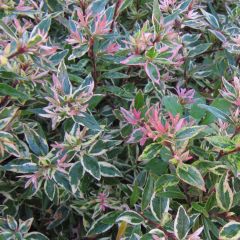
Abelia x grandiflora Confetti
- Flowering time August to November
- Height at maturity 90 cm
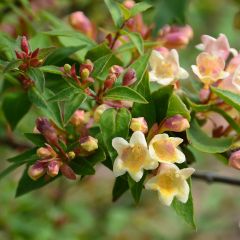
Abelia x grandiflora Sunny Charm MINDUO1
- Flowering time August to November
- Height at maturity 1 m
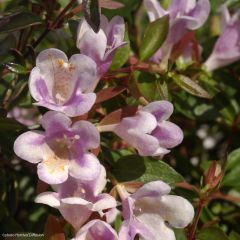
Abelia grandiflora Pastel Charm
- Flowering time August to November
- Height at maturity 1 m
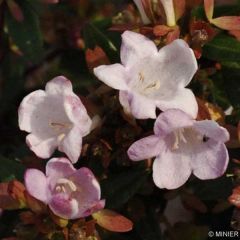
Abelia grandiflora Petite Garden
- Flowering time August to October
- Height at maturity 90 cm
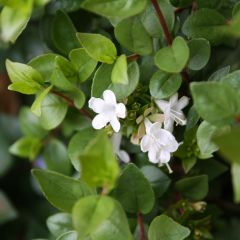
Abelia zanderi Little Richard
- Flowering time August to November
- Height at maturity 60 cm
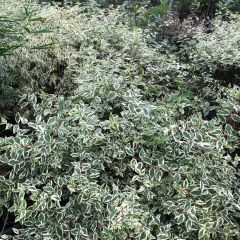
Abelia grandiflora Sparkling Silver
- Flowering time August to November
- Height at maturity 50 cm
Discover other Abelia
Planting
While it has moderate cold resistance, down to -10/-12°C, Abelia is best planted in regions south of the Loire where winters are relatively mild. It shows good tolerance to sea spray. However, it should be planted sheltered from cold, dry winds, which can damage the foliage and flowering, especially when young: train it against a south-facing wall if you wish to grow it in a region with harsh winters.
It prefers full sun for optimal flowering but tolerates partial shade well.
Not fussy about soil type, it grows in any good, well-drained garden soil, even chalky, but avoid overly wet conditions: it dislikes heavy, compacted or waterlogged soils. It thrives in soils that remain cool, but as it matures, it will tolerate occasional summer dryness. In colder areas, a thick mulch is recommended during the first winters or in exceptionally cold spells.
Often wider than tall, Abelia can be used as a standalone specimen, in a free-flowering or low hedge, in perennial borders or alongside other shrubs, paired with dark or variegated evergreens to highlight its flowers, foliage and stems.
The compact size of some varieties makes them ideal for container growing on a terrace or balcony, allowing you to fully enjoy their remarkable summer fragrance.
→ Discover our guide: Growing Abelia in a Pot
When to Plant?
Plant Abelia either in spring (March) or autumn (October). However, in colder regions, it can reasonably be planted from February to May, while in warmer areas, autumn planting (September to November) is preferable—avoid frost or extreme heat.
How to Plant Abelia?
Depending on the variety and intended use, space plants 60 cm apart for low, bushy types to create dense clumps. For taller varieties or hedges, space them 80 cm to 1.20 m apart.
- Dig a hole three times wider than the root ball and about 50 cm deep
- Use some of the excavated soil to form a small mound at the base to support the roots
- Mix the remaining soil with equal parts compost
- Optionally, add a layer of gravel for perfect drainage
- Place the Abelia in the centre, with the root collar level with the ground
- Backfill with the soil mixture, firming gently around the roots
- Keep the shrub upright
- Tamp down with your foot
- Water thoroughly after planting and weekly during the first year
Container Growing
Container cultivation is possible, especially with compact varieties. Repot every three years and prune regularly to control growth. Keep the soil moist in summer, mulch heavily in winter or move pots to shelter during severe frosts.
Maintenance, Pruning and Care
Low-maintenance, the Abelia is easy to grow and requires little care. It can be easily pruned with shears or hedge trimmers each year, depending on the shape you wish to achieve (especially when planted as a trimmed hedge), to maintain a compact and balanced form, encourage growth, and stimulate flowering. Prune in late winter, between February and April, before new growth begins, removing any crossing, weak, or dead branches at their base to keep only the most vigorous ones.
→ Also read our advice in our tutorial: How to Prune Abelia?
In case of prolonged drought, and during the first two years, monitor your shrub’s water needs.
It is best to mulch generously around the base before winter and for the first three years after planting. A winter protection fleece may be useful to shield it from harsh frosts.
Pests and potential diseases
Abelia is never sick, it is resistant to most diseases and unaffected by pest attacks.
Propagation
The simplest and quickest method to propagate Abelia is through cuttings.
By cuttings
Propagation is done using semi-hardwood cuttings (when the shoots begin to turn woody) in July-August:
- After flowering, take cuttings 6 to 12 cm long
- Insert the cuttings three-quarters deep into a light, well-draining substrate (peat and river sand), keeping it moist and spacing them 5 cm apart
- Place the tray or pot in the shade outdoors under a mini greenhouse until autumn, then under a cold frame during winter
- Transplant them into the ground the following spring
⇒ To learn more, check out our illustrated guide: How to take cuttings from Abelia?
Pair with
If you love Abelia for its easy cultivation, it is also highly prized for its ornamental appeal throughout much of the year: in summer it becomes covered in an abundance of fragrant white or pink flowers, then its green or golden foliage takes on fiery copper or bronze hues in autumn.
Abelia works equally well planted in groups with other shrubs or as a standalone specimen, in borders with perennials, as part of a free-growing or trimmed hedge, and even as ground cover for the lowest-growing varieties. It creates a beautiful contrast with warm colours, gold-variegated foliage, and shrubs with red-orange leaves like Photinia.
In a flowering hedge, it will be the perfect companion for Pyracanthas, Caryopteris, Kolkwitzia amabilis or “Beauty Bush”, Deutzia, Berberis, Philadelphus, Lilacs, shrub roses, or near a Buddleia.
It will look stunning alongside flowering shrubs with decorative foliage that will highlight its blooms and fiery autumn leaves, creating either perfect harmony or striking contrasts; Choisya, Leycesteria formosa, Spirea, Euonymus, Viburnum or Dogwoods.
Its slightly unruly shape will benefit from being paired with plants with a more structured habit like bamboos, pampas grass, Panicum or Japanese maples.
In a summer border, it can be combined with Delphiniums, Agastache, hardy Geraniums… In autumn, it pairs well with Asters, Japanese Anemones, Tricyrtis, Heleniums…
It also grows very well in large pots on patios, perfuming summer evenings.
→ More ideas for pairing with Abelia in our advice sheet
To go further
Discover:
- Our wide range of Abelias
- As well as our practical advice in our guide: “Abelia: planting, pruning and care”, How to choose an Abelia?
- Our expert guide: Pairing an Abelia
- Explore our varieties:
- Abelias by flower colour: 7 White-flowered Abelias for a luminous garden; Top 7 Pink-flowered Abelias to brighten your garden
- Subscribe!
- Contents






































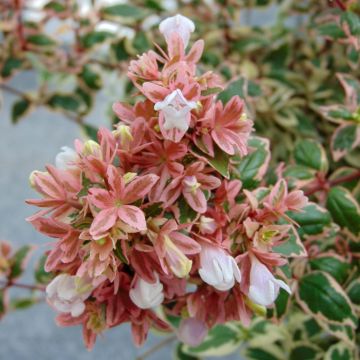

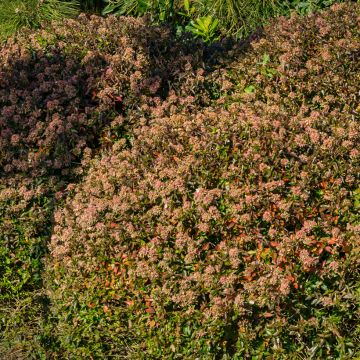



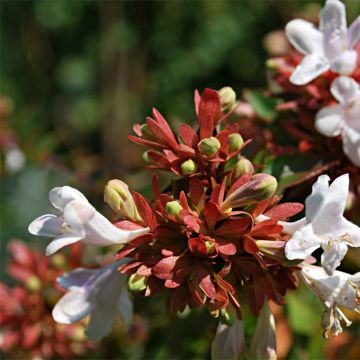
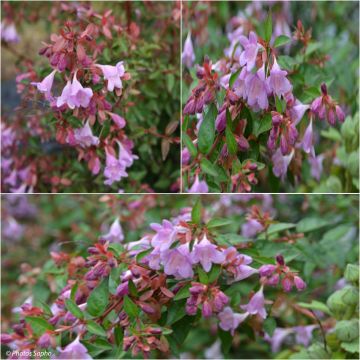
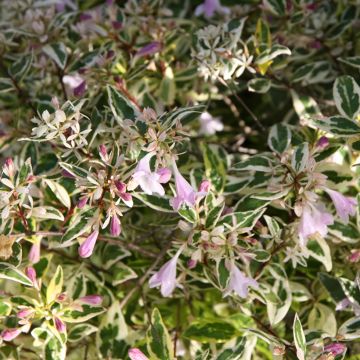
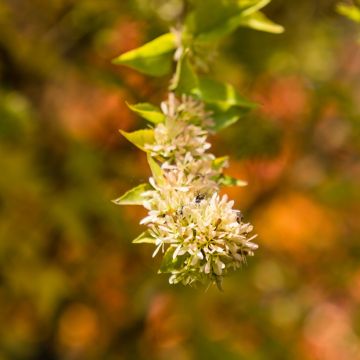
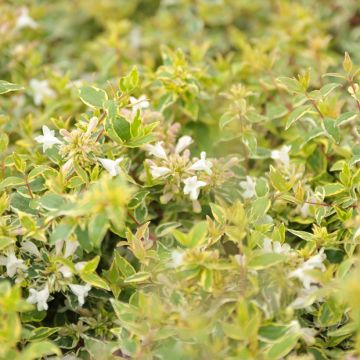
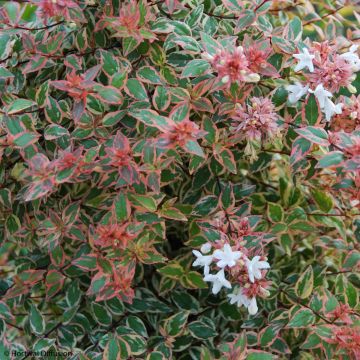

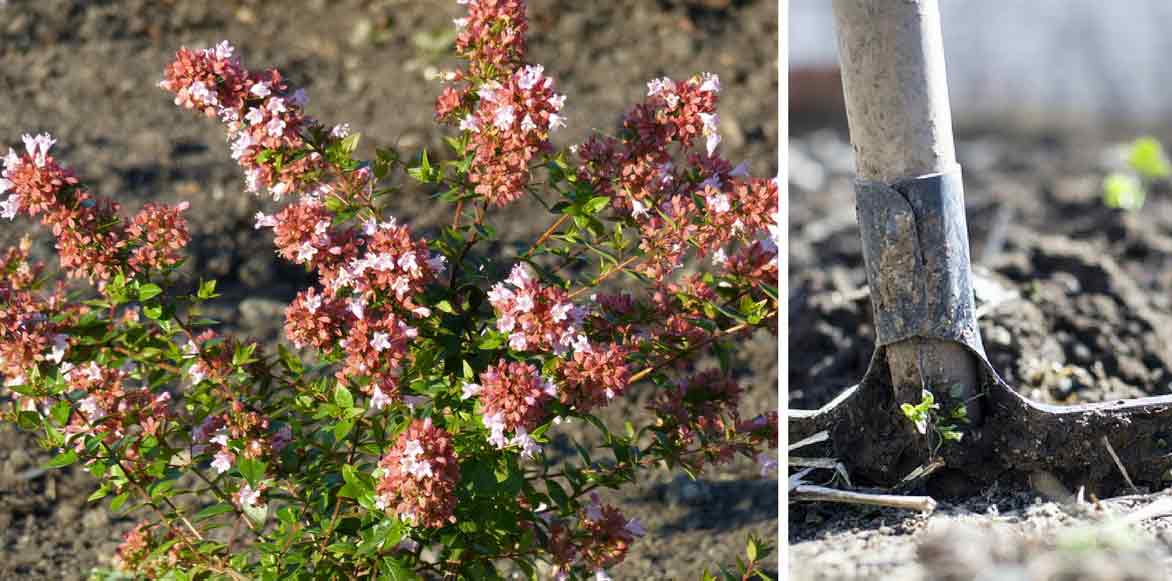
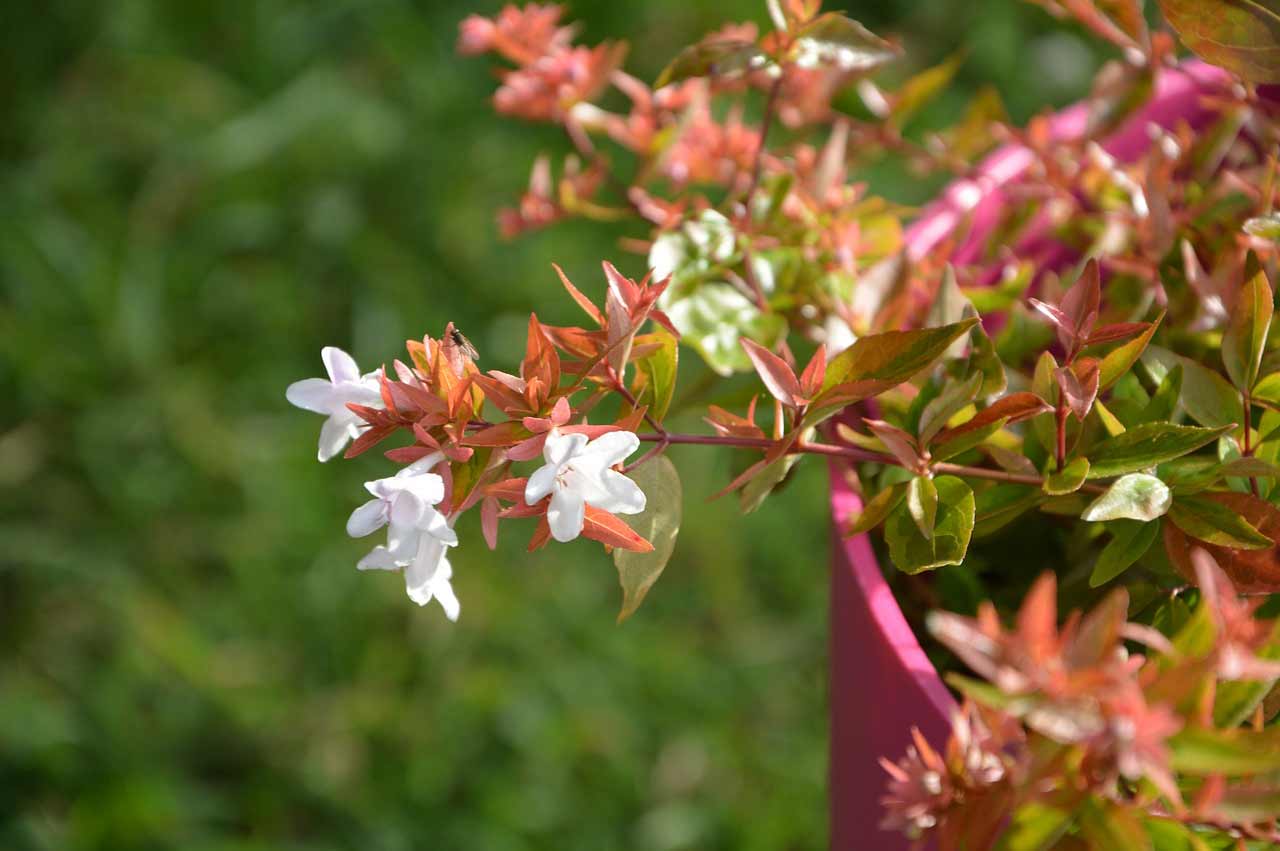

Comments